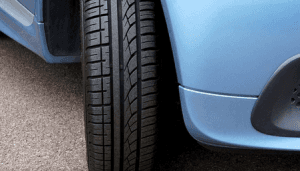Driving On Overinflated Tires – Is It Dangerous?
We often get comments/emails from drivers asking different questions about tire pressure, but one in particular really got our attention.

He spoke to how bad the traction was on both dry or wet roads, and the ride was much rougher on these new tires than it was on his older set. Why was this happening? Are these simply junk tires that he had purchased?
In talking back and forth, Dan mentioned that he aired up the tires to 44 psi all the way around. Immediately, the red flag went up. It wasn’t a tire issue at all. Instead, it was an inflation issue.
The placard on the door frame of his Camry stated the inflation pressure should be set at 35 psi. However, the psi listed on the sidewall of the tire stated a much higher limit of 51 psi.
Dan thought he was doing right by airing his tires to 44 psi, thinking it would give him a comfortable ride and great handling. (Once we talked about setting the psi to the correct recommendations, he is now enjoying his new tires and is no longer having any issues.)
What Happens When You Drive On Overinflated Tires?
There are several areas of concern when it comes to driving your vehicle with tires that are overfilled with air.
Loss Of Traction And Reduced Braking
One of the biggest problems is going to be a loss of traction, particularly on wet pavement. Over inflation reduces the contact patch between the tire and the road. The result is worse traction, less grip and reduced braking performance. Wet roads only magnify the situation. Altogether, this can quickly become a recipe for disaster during an emergency maneuver.
Uneven Treadwear
The same traction and handling issues due to a much smaller contact patch will also create uneven treadwear. Since only the middle portion of the tire is making contact with the road surface, it only stands to reason that the middle of your tire is going to wear much quicker.
Decreased Ride Comfort
Driving on overinflated tires is somewhat similar to riding in a covered wagon. The ride is rough, jarring and unforgiving. The tire lacks the ability to absorb any of the impact from road imperfections because it is overinflated. Not good, unless visiting your chiropractor for a back adjustment is something you look forward to.
What Should You Do To Prevent Over Inflation Issues?
The best thing you can do is to check your tire pressure on a regular basis. Take the time once or twice a month to check the pressure before driving off. (It’s always recommended to check the psi when the tire is cold.)
Use a good tire gauge. Digital tire pressure gauges work very well, but even the old stick gauges are better than not checking at all.
Finally, be sure to always use the recommended psi for your particular vehicle. Generally speaking, the placard will be located on the inside of the drivers door or doorjamb. It may also be in the owners manual.
In case you may be wondering if it’s ok to drive on underinflated tires, you don’t want to do that either. It’s equally as dangerous on the highway. (Low tire pressure was the issue with the Ford Explorers several years ago.)
Share this article

An employee at Mr. Tire overinflated my tires to 60 when they should be only 32!!! I didn’t find out until like 3 weeks later. How much danage has been sone to my tires? I noticed today on my morning commute, I was not bavigating ramp curces well. My car was sliding! These tires were new when put on my vehicle last July!
Can you tell me about your RV tires:27.5/70/R22.5.
Hey James, I will get back to you after a little more research.
It pays to consult the owner’s manual because the recommended tire pressure may depend on the load and speed rating of the tire.
We recommend always going by the psi recommended by the vehicle manufacturer, which is located on the drivers side door pillar in most cases. Don’t go by the max pressure that is stamped on the sidewall of the tire.
I have 225/70R16 they say on the tire max 44PSI what number should I put in the tire 44 ?
Moderators/Admins:
There is a prevailing attitude when it comes to setting tire pressure that the cold pressure listed on the vehicle frame or manual is considered “underinflated”. I can understand this mentality when it comes to the most prominent tire & vehicle controversy of recent times – that of the 26psi Ford Explorer, and Firestone, but only in that instance.
How can we dispel that myth?